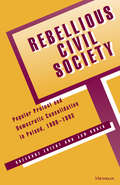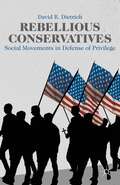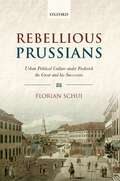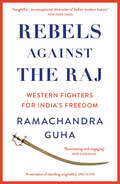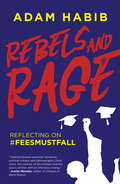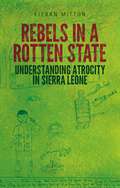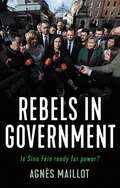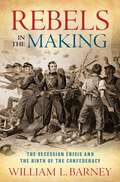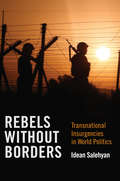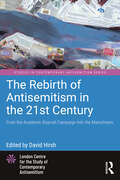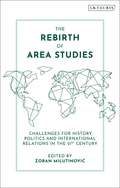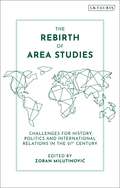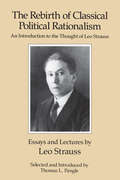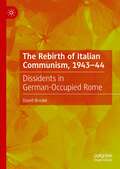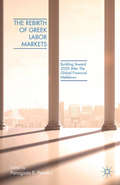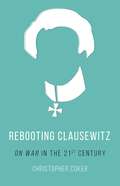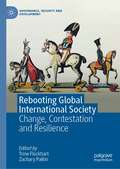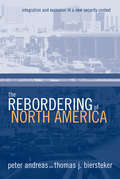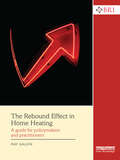- Table View
- List View
Rebellious Civil Society: Popular Protest and Democratic Consolidation in Poland, 1989-1993
by Grzegorz Ekiert Jan KubikPoland is the only country in which popular protest and mass opposition, epitomized by the Solidarity movement, played a significant role in bringing down the communist regime. This book, the first comprehensive study of the politics of protest in postcommunist Central Europe, shows that organized protests not only continued under the new regime but also had a powerful impact on Poland's democratic consolidation. Following the collapse of communism in 1989, the countries of Eastern Europe embarked on the gargantuan project of restructuring their social, political, economic, and cultural institutions. The social cost of these transformations was high, and citizens expressed their discontent in various ways. Protest actions became common events, particularly in Poland. In order to explain why protest in Poland was so intense and so particularized, Grzegorz Ekiert and Jan Kubik place the situation within a broad political, economic, and social context and test it against major theories of protest politics. They conclude that in transitional polities where conventional political institutions such as parties or interest groups are underdeveloped, organized collective protest becomes a legitimate and moderately effective strategy for conducting state-society dialogue. The authors offer an original and rich description of protest movements in Poland after the fall of communism as a basis for developing and testing their ideas. They highlight the organized and moderate character of the protests and argue that the protests were not intended to reverse the change of 1989 but to protest specific policies of the government. This book contributes to the literature on democratic consolidation, on the institutionalization of state-society relationship, and on protest and social movements. It will be of interest to political scientists, sociologists, historians, and policy advisors. Grzegorz Ekiert is Professor of Government, Harvard University. Jan Kubik is Associate Professor of Political Science, Rutgers University.
Rebellious Conservatives: Social Movements in Defense of Privilege
by David R. DietrichRebellious Conservatives analyzes three movements, the anti-abortion/pro-life movement, the anti-illegal immigration movement, and the Tea Party, to show how perceptions of threats to their privileges drives conservative protest and how these movements seek to reshape America.
Rebellious Prussians: Urban Political Culture Under Frederick The Great And His Successors
by Florian SchuiRebels Against the Raj: Western Fighters For India's Freedom
by Ramachandra GuhaAn extraordinary history of resistance and the fight for Indian independence from Ramachandra Guha.
Rebels and Rage: Reflecting on #FeesMustFall
by Adam HabibAdam Habib, the most prominent and outspoken university official through the recent student protests, takes a characteristically frank view of the past three years on South Africa’s campuses in this new book. Habib charts the progress of the student protests that erupted on Wits University campus in late 2015 and raged for the better part of three years, drawing on his own intimate involvement and negotiation with the students, and also records university management and government responses to the events. He critically examines the student movement and individual student leaders who emerged under the banners #feesmustfall and #Rhodesmustfall, and debates how to achieve truly progressive social change in South Africa, on our campuses and off.This book is both an attempt at a historical account and a thoughtful reflection on the issues the protests kicked up, from the perspective not only of a high-ranking member of university management, but also Habib as political scientist with a background as an activist during the struggle against apartheid. Habib moves between reflecting on the events of the last three years on university campuses, and reimagining the future of South African higher education.Adam Habib, the most prominent and outspoken university official through the recent student protests, takes a characteristically frank view of the past three years on South Africa’s campuses in this new book. Habib charts the progress of the student protests that erupted on Wits University campus in late 2015 and raged for the better part of three years, drawing on his own intimate involvement and negotiation with the students, and also records university management and government responses to the events. He critically examines the student movement and individual student leaders who emerged under the banners #feesmustfall and #Rhodesmustfall, and debates how to achieve truly progressive social change in South Africa, on our campuses and off.This book is both an attempt at a historical account and a thoughtful reflection on the issues the protests kicked up, from the perspective not only of a high-ranking member of university management, but also Habib as political scientist with a background as an activist during the struggle against apartheid. Habib moves between reflecting on the events of the last three years on university campuses, and reimagining the future of South African higher education.
Rebels in a Rotten State: Understanding Atrocity in the Sierra Leone Civil War
by Kieran MittonThe atrocities of civil wars present us with many difficult questions. How do seemingly ordinary individuals come to commit such extraordinary acts of cruelty, often against unarmed civilians? Can we ever truly understand such acts of 'evil'? Based on a wealth of original interviews with perpetrators of violence in Sierra Leone's civil war, this book provides a detailed response. Moving beyond the rigid bounds of political science, the author engages with sociology, psychology and social psychology, to provide a comprehensive picture of the complex individual motives behind seemingly senseless violence in Sierra Leone's war. Highlighting the inadequacy of current explanations that centre on the anarchic nature of brutality, or conversely, its calculated rationality, this book sheds light on the critical but hitherto neglected role played by the emotions of shame and disgust. Drawing on first-hand accounts of strategies employed by Sierra Leone's rebel commanders, it documents the manner in which rebel recruits were systematically brutalised and came to perform horrifying acts of cruelty as routine. In so doing, it offers fresh insight into the causes of extreme violence that holds relevance beyond Sierra Leone to the atrocities of contemporary civil wars.
Rebels in a Rotten State: Understanding Atrocity in the Sierra Leone Civil War
by Kieran MittonThe atrocities of civil wars present us with many difficult questions. How do seemingly ordinary individuals come to commit such extraordinary acts of cruelty, often against unarmed civilians? Can we ever truly understand such acts of 'evil'? Based on a wealth of original interviews with perpetrators of violence in Sierra Leone's civil war, this book provides a detailed response. Moving beyond the rigid bounds of political science, the author engages with sociology, psychology and social psychology, to provide a comprehensive picture of the complex individual motives behind seemingly senseless violence in Sierra Leone's war. Highlighting the inadequacy of current explanations that centre on the anarchic nature of brutality, or conversely, its calculated rationality, this book sheds light on the critical but hitherto neglected role played by the emotions of shame and disgust. Drawing on first-hand accounts of strategies employed by Sierra Leone's rebel commanders, it documents the manner in which rebel recruits were systematically brutalised and came to perform horrifying acts of cruelty as routine. In so doing, it offers fresh insight into the causes of extreme violence that holds relevance beyond Sierra Leone to the atrocities of contemporary civil wars.
Rebels in government: Is Sinn Féin ready for power?
by Agnès MaillotThe February 2020 general election in the Republic of Ireland sent shockwaves through the country’s political system. Sinn Féin, ahead of all other parties in terms of first preference votes, secured its place as a potential coalition partner, a role it has been playing in Northern Ireland since the start of the century. This result not only disrupted the two-party system, it also questioned a narrative that had cast Sinn Féin as an outlier in the political mainstream. However, the prospect of this all-Ireland, radical left and former Provisional IRA associate being in government raises many questions: what does the success of this all-Ireland party say about the prospect of reunification? Can a party over which the shadow of paramilitaries still lingers be fully trusted? And are the radical changes that the party advocates in areas such as housing, public health and taxation a compelling alternative? These are the questions that this book sets out to address.
Rebels in government: Is Sinn Féin ready for power?
by Agnès MaillotThe February 2020 general election in the Republic of Ireland sent shockwaves through the country’s political system. Sinn Féin, ahead of all other parties in terms of first preference votes, secured its place as a potential coalition partner, a role it has been playing in Northern Ireland since the start of the century. This result not only disrupted the two-party system, it also questioned a narrative that had cast Sinn Féin as an outlier in the political mainstream. However, the prospect of this all-Ireland, radical left and former Provisional IRA associate being in government raises many questions: what does the success of this all-Ireland party say about the prospect of reunification? Can a party over which the shadow of paramilitaries still lingers be fully trusted? And are the radical changes that the party advocates in areas such as housing, public health and taxation a compelling alternative? These are the questions that this book sets out to address.
Rebels in the Making: The Secession Crisis and the Birth of the Confederacy
by William L. BarneyRegardless of whether they owned slaves, Southern whites lived in a world defined by slavery. As shown by their blaming British and Northern slave traders for saddling them with slavery, most were uncomfortable with the institution. While many wanted it ended, most were content to leave that up to God. All that changed with the election of Abraham Lincoln. Rebels in the Making is a narrative-driven history of how and why secession occurred. In this work, senior Civil War historian William L. Barney narrates the explosion of the sectional conflict into secession and civil war. Carefully examining the events in all fifteen slave states and distinguishing the political circumstances in each, he argues that this was not a mass democratic movement but one led from above. The work begins with the deepening strains within Southern society as the slave economy matured in the mid-nineteenth century and Southern ideologues struggled to convert whites to the orthodoxy of slavery as a positive good. It then focuses on the years of 1860-1861 when the sectional conflict led to the break-up of the Union. As foreshadowed by the fracturing of the Democratic Party over the issue of federal protection for slavery in the territories, the election of 1860 set the stage for secession. Exploiting fears of slave insurrections, anxieties over crops ravaged by a long drought, and the perceived moral degradation of submitting to the rule of an antislavery Republican, secessionists launched a movement in South Carolina that spread across the South in a frenzied atmosphere described as the great excitement. After examining why Congress was unable to reach a compromise on the core issue of slavery's expansion, the study shows why secession swept over the Lower South in January of 1861 but stalled in the Upper South. The driving impetus for secession is shown to have come from the middling ranks of the slaveholders who saw their aspirations of planter status blocked and denigrated by the Republicans. A separate chapter on the formation of the Confederate government in February of 1861 reveals how moderates and former conservatives pushed aside the original secessionists to assume positions of leadership. The final chapter centers on the crisis over Fort Sumter, the resolution of which by Lincoln precipitated a second wave of secession in the Upper South. Rebels in the Making shows that secession was not a unified movement, but has its own proponents and patterns in each of the slave states. It draws together the voices of planters, non-slaveholders, women, the enslaved, journalists, and politicians. This is the definitive study of the seminal moment in Southern history that culminated in the Civil War.
Rebels in the Making: The Secession Crisis and the Birth of the Confederacy
by William L. BarneyRegardless of whether they owned slaves, Southern whites lived in a world defined by slavery. As shown by their blaming British and Northern slave traders for saddling them with slavery, most were uncomfortable with the institution. While many wanted it ended, most were content to leave that up to God. All that changed with the election of Abraham Lincoln. Rebels in the Making is a narrative-driven history of how and why secession occurred. In this work, senior Civil War historian William L. Barney narrates the explosion of the sectional conflict into secession and civil war. Carefully examining the events in all fifteen slave states and distinguishing the political circumstances in each, he argues that this was not a mass democratic movement but one led from above. The work begins with the deepening strains within Southern society as the slave economy matured in the mid-nineteenth century and Southern ideologues struggled to convert whites to the orthodoxy of slavery as a positive good. It then focuses on the years of 1860-1861 when the sectional conflict led to the break-up of the Union. As foreshadowed by the fracturing of the Democratic Party over the issue of federal protection for slavery in the territories, the election of 1860 set the stage for secession. Exploiting fears of slave insurrections, anxieties over crops ravaged by a long drought, and the perceived moral degradation of submitting to the rule of an antislavery Republican, secessionists launched a movement in South Carolina that spread across the South in a frenzied atmosphere described as the great excitement. After examining why Congress was unable to reach a compromise on the core issue of slavery's expansion, the study shows why secession swept over the Lower South in January of 1861 but stalled in the Upper South. The driving impetus for secession is shown to have come from the middling ranks of the slaveholders who saw their aspirations of planter status blocked and denigrated by the Republicans. A separate chapter on the formation of the Confederate government in February of 1861 reveals how moderates and former conservatives pushed aside the original secessionists to assume positions of leadership. The final chapter centers on the crisis over Fort Sumter, the resolution of which by Lincoln precipitated a second wave of secession in the Upper South. Rebels in the Making shows that secession was not a unified movement, but has its own proponents and patterns in each of the slave states. It draws together the voices of planters, non-slaveholders, women, the enslaved, journalists, and politicians. This is the definitive study of the seminal moment in Southern history that culminated in the Civil War.
Rebels without Borders: Transnational Insurgencies in World Politics
by Idean SalehyanRebellion, insurgency, civil war-conflict within a society is customarily treated as a matter of domestic politics and analysts generally focus their attention on local causes. Yet fighting between governments and opposition groups is rarely confined to the domestic arena. "Internal" wars often spill across national boundaries, rebel organizations frequently find sanctuaries in neighboring countries, and insurgencies give rise to disputes between states. In Rebels without Borders, which will appeal to students of international and civil war and those developing policies to contain the regional diffusion of conflict, Idean Salehyan examines transnational rebel organizations in civil conflicts, utilizing cross-national datasets as well as in-depth case studies. He shows how external Contra bases in Honduras and Costa Rica facilitated the Nicaraguan civil war and how the Rwandan civil war spilled over into the Democratic Republic of the Congo, fostering a regional war. He also looks at other cross-border insurgencies, such as those of the Kurdish PKK and Taliban fighters in Pakistan. Salehyan reveals that external sanctuaries feature in the political history of more than half of the world's armed insurgencies since 1945, and are also important in fostering state-to-state conflicts. Rebels who are unable to challenge the state on its own turf look for mobilization opportunities abroad. Neighboring states that are too weak to prevent rebel access, states that wish to foster instability in their rivals, and large refugee diasporas provide important opportunities for insurgent groups to establish external bases. Such sanctuaries complicate intelligence gathering, counterinsurgency operations, and efforts at peacemaking. States that host rebels intrude into negotiations between governments and opposition movements and can block progress toward peace when they pursue their own agendas.
The Rebirth of Antisemitism in the 21st Century: From the Academic Boycott Campaign into the Mainstream (Studies in Contemporary Antisemitism)
by David HirshThe Rebirth of Antisemitism in the 21st Century is about the rise of antizionism and antisemitism in the first two decades of the 21st century, with a focus on the UK. It is written by the activist-intellectuals, both Jewish and not, who led the opposition to the campaign for an academic boycott of Israel. Their experiences convinced them that the boycott movement, and the antizionism upon which it was based, was fuelled by, and in turn fuelled, antisemitism. The book shows how the level of hostility towards Israel exceeded the hostility which is levelled against other states. And it shows how the quality of that hostility tended to resonate with antisemitic tropes, images and emotions. Antizionism positioned Israel as symbolic of everything that good people oppose, it made Palestinians into an abstract symbol of the oppressed, and it positioned most Jews as saboteurs of social ‘progress’. The book shows how antisemitism broke into mainstream politics and how it contaminated the Labour Party as it made a bid for Downing Street. This book will be of interest to scholars and students researching antizionism, antisemitism and the Labour Party in the UK.
The Rebirth of Antisemitism in the 21st Century: From the Academic Boycott Campaign into the Mainstream (Studies in Contemporary Antisemitism)
The Rebirth of Antisemitism in the 21st Century is about the rise of antizionism and antisemitism in the first two decades of the 21st century, with a focus on the UK. It is written by the activist-intellectuals, both Jewish and not, who led the opposition to the campaign for an academic boycott of Israel. Their experiences convinced them that the boycott movement, and the antizionism upon which it was based, was fuelled by, and in turn fuelled, antisemitism. The book shows how the level of hostility towards Israel exceeded the hostility which is levelled against other states. And it shows how the quality of that hostility tended to resonate with antisemitic tropes, images and emotions. Antizionism positioned Israel as symbolic of everything that good people oppose, it made Palestinians into an abstract symbol of the oppressed, and it positioned most Jews as saboteurs of social ‘progress’. The book shows how antisemitism broke into mainstream politics and how it contaminated the Labour Party as it made a bid for Downing Street. This book will be of interest to scholars and students researching antizionism, antisemitism and the Labour Party in the UK.
The Rebirth of Area Studies: Challenges for History, Politics and International Relations in the 21st Century
by Zoran MilutinovićArea Studies became increasingly common after World War II as a means of responding to perceived 'external threats' from the Soviet Union and China. After the Cold War and in the face of increasingly rapid globalisation, it seemed inevitable that Area Studies – institutionally and intellectually – would slowly degenerate. But this has not been the case, and there has recently been a resurgence of interest in it as an effective and positive research paradigm. Responding to this renewed interest, this book brings together an esteemed group of contributors at the cutting edge of the field to consider the state of Area Studies today and its prospects for the future. The Rebirth of Area Studies demonstrates that numerous aspects of the research paradigm in fact recommend it as well-suited for the present moment and the challenges posed by globalisation, both as a means to overcome disciplinary limitations and to increase self-reflexivity. Area Studies research is grounded in place-specific knowledge, yet by definition it transcends nation as the basic unit of analysis and thus empowers comparative and trans-national approaches. This book outlines a new, critical Area Studies for the 21st century – self-reflexive, aware of its limitations and conscious of its origins in geopolitical, strategic or ideological considerations – and is essential reading for historians, geographers and political scientists.
The Rebirth of Area Studies: Challenges for History, Politics and International Relations in the 21st Century
Area Studies became increasingly common after World War II as a means of responding to perceived 'external threats' from the Soviet Union and China. After the Cold War and in the face of increasingly rapid globalisation, it seemed inevitable that Area Studies – institutionally and intellectually – would slowly degenerate. But this has not been the case, and there has recently been a resurgence of interest in it as an effective and positive research paradigm. Responding to this renewed interest, this book brings together an esteemed group of contributors at the cutting edge of the field to consider the state of Area Studies today and its prospects for the future. The Rebirth of Area Studies demonstrates that numerous aspects of the research paradigm in fact recommend it as well-suited for the present moment and the challenges posed by globalisation, both as a means to overcome disciplinary limitations and to increase self-reflexivity. Area Studies research is grounded in place-specific knowledge, yet by definition it transcends nation as the basic unit of analysis and thus empowers comparative and trans-national approaches. This book outlines a new, critical Area Studies for the 21st century – self-reflexive, aware of its limitations and conscious of its origins in geopolitical, strategic or ideological considerations – and is essential reading for historians, geographers and political scientists.
The Rebirth of Classical Political Rationalism: An Introduction to the Thought of Leo Strauss
by Leo StraussThis concise and accessible introduction to Strauss's thought provides, for wider audience, a bridge to his more complex theoretical work. Editor Pangle has gathered five of Strauss's previously unpublished lectures and five hard-to-find published writings and has arranged them so as to demonstrate the systematic progression of the major themes that underlay Strauss's mature work. "[These essays] display the incomparable insight and remarkable range of knowledge that set Strauss's works apart from any other twentieth-century philosopher's."—Charles R. Kesler, National Review
The Rebirth of Italian Communism, 1943–44: Dissidents in German-Occupied Rome
by David BroderDuring the final years of the Second World War, a decisive change took place in the Italian left, as the Italian Communist Party (PCI) rose from clandestinity and recast itself as a mass, patriotic force committed to building a new democracy. This book explains how this new party came into being. Using Rome as its focus, it explains that the rebirth of the PCI required that it subdue other, dissident strands of communist thinking. During the nine-month German occupation of Rome in 1943-44, dissident communists would create the capital’s largest single resistance formation, the Communist Movement of Italy (MCd’I), which galvanised a social revolt in the capital's borgate slums. Exploring this wartime battle to define the rebirth of Italian communism, the author examines the ways in which a militant minority of communists rooted their activity in the everyday lives of the population under occupation. In particular, this study focuses on the role of draft resistance and the revolt against labour conscription in driving recruitment to partisan bands, and how communist militants sought to mould these recruits through an active effort of political education. Studying the political writing of these dissidents, their autodidact Marxism and the social conditions in which it emerged, this book also sheds light on an often-ignored underground culture in the years that preceded the armed resistance that began in September 1943. Revealing an almost unknown history of dissident communism in Italy, outside of more recognisable traditions like Trotskyism or Bordigism, this book provides an innovative perspective on Italian history. It will be of interest to those researching the broad topics of political and social history, but more specifically, resistance in the Second World War and the post-war European left.
The Rebirth of the Greek Labor Market: Building Toward 2020 After the Global Financial Meltdown
by Panagiotis E. PetrakisThe Rebirth of the Greek Labor Market provides evidence of the macroeconomic evolution of the Greek economy, as well as current conditions in the labor market, to suggest potential areas of growth following the crisis. The contributors of this collection focus on three main issues that make the overall volume distinctive. Firstly, the authors develop a macro-econometric model for the Greek economy, which is flexible in terms of policy analysis and provides reasonable forecasts for the period between 2014-2020, under three scenarios. Secondly, the authors analyze the dynamism in the Greek economy, as well as the problematic Greek labor market. Lastly, using the estimations provided by the macro-econometric model developed, an input-output analysis is conducted - for every one of the three scenarios - in order to investigate and quantify the impact of the economic crisis, not only to the total employment but also in the number of employees by occupation, for all productive sectors of the economy. Using this structure, this indispensable new volume identifies the occupations, professions, and sectors with the greatest losses, as well as those showing a positive momentum, up to 2020.
Rebooting Clausewitz: 'On War' in the Twenty-First Century
by Christopher CokerRebooting Clausewitz offers an entirely new take on the work of history's greatest theorist of war. Written for an undergraduate readership that often struggles with Clausewitz's master work On War--a book that is often considered too philosophical and impenetrably dense--it seeks to unpack some of Clausewitz's key insights on theory and strategy. In three fictional interludes Clausewitz attends a seminar at West Point; debates the War on Terror at a Washington think tank; and visits a Robotics Institute in Santa Fe where he discusses how scientists are reshaping the future of war. Three separate essays situate Clausewitz in the context of his times, discuss his understanding of the culture of war, and the extent to which two other giants--Thucydides and Sun Tzu--complement his work. Some years ago the philosopher W.B. Gallie argued that Clausewitz needed to be 'saved from the Clausewitzians'. Clausewitz doesn't need saving and his commentators have contributed a great deal to our understanding of On War's seminal status as a text. But too often they tend to conduct a conversation between themselves. This book is an attempt to let a wider audience into the conversation.
Rebooting Clausewitz: 'On War' in the Twenty-First Century
by Christopher CokerRebooting Clausewitz offers an entirely new take on the work of history's greatest theorist of war. Written for an undergraduate readership that often struggles with Clausewitz's master work On War--a book that is often considered too philosophical and impenetrably dense--it seeks to unpack some of Clausewitz's key insights on theory and strategy. In three fictional interludes Clausewitz attends a seminar at West Point; debates the War on Terror at a Washington think tank; and visits a Robotics Institute in Santa Fe where he discusses how scientists are reshaping the future of war. Three separate essays situate Clausewitz in the context of his times, discuss his understanding of the culture of war, and the extent to which two other giants--Thucydides and Sun Tzu--complement his work. Some years ago the philosopher W.B. Gallie argued that Clausewitz needed to be 'saved from the Clausewitzians'. Clausewitz doesn't need saving and his commentators have contributed a great deal to our understanding of On War's seminal status as a text. But too often they tend to conduct a conversation between themselves. This book is an attempt to let a wider audience into the conversation.
Rebooting Global International Society: Change, Contestation and Resilience (Governance, Security and Development)
by Trine Flockhart Zachary PaikinThis book asks if it is time to “reboot” the fundamental institutions of global international society. The volume revisits Hedley Bull’s seminal contribution The Anarchical Society by exploring the interconnected nature of change, contestation and resilience for maintaining order in today’s uncertain and complex environment. The volume adds to Bull’s theorizing by recognizing that order demands change, that contestation should be welcomed, and that resilience is anchored in local and agent-led forms of ordering. The contributors to Part One of the book focus on theoretical and conceptual issues related to order in the global international society, whilst the contributors to Part Two of the book focus on the primary institutions as listed by Hedley Bull with the addition of a chapter on the market adding a distinctive commentary on new and important dynamics of change, contestation and resilience of the existing institutions.
The Rebordering of North America: Integration and Exclusion in a New Security Context
by Peter Andreas Thomas J. BierstekerFirst Published in 2003. Routledge is an imprint of Taylor & Francis, an informa company.
The Rebordering of North America: Integration and Exclusion in a New Security Context
by Peter Andreas Thomas J. BierstekerFirst Published in 2003. Routledge is an imprint of Taylor & Francis, an informa company.
The Rebound Effect in Home Heating: A guide for policymakers and practitioners (Building Research and Information)
by Ray GalvinThis is a definitive guide to the rebound effect in home heating – the increase in energy service use after a technological intervention aimed at reducing consumption. It sets out what the effect is, how it plays out in the home heating sector, what this implies for energy saving initiatives in this sector, and how it relates to rebound effects in other sectors. The book outlines how the concept of the rebound effect has been developed and the scope of research on it, both generally and particularly in the home heating sector. Within the context of energy and CO2 emissions policy, it summarises the empirical evidence, exploring its causes and the attempts that are being made to mitigate it. Various definitions of the rebound effect are considered, in particular the idea of the effect as an energy-efficiency ‘elasticity’. The book shows how this definition can be rigorously applied to thermal retrofits, and to national consumption data, to give logically consistent rebound effect results that can be coherently compared with those of other sectors, and allow policy makers to have more confidence in the predictions about potential energy savings.
